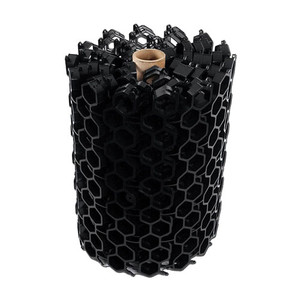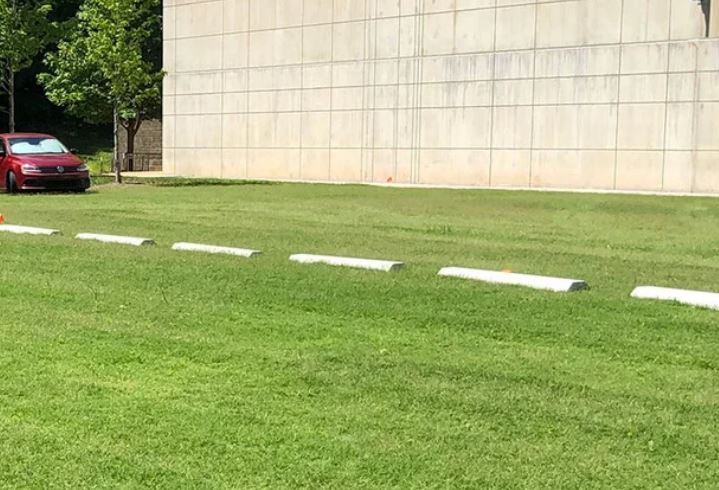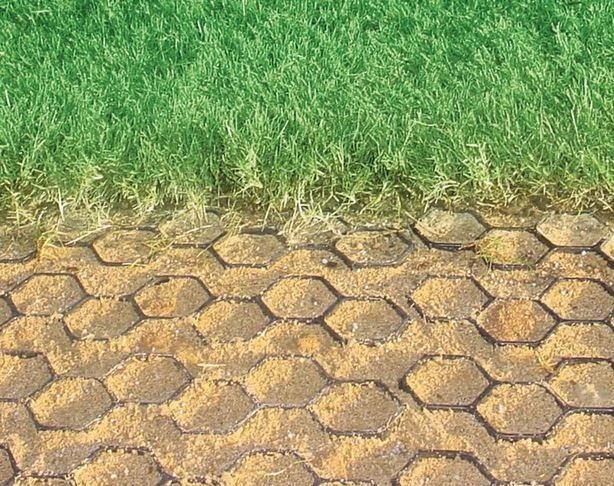
EZ-Roll Grass Pavers by NDS
Overview
NDS EZ Roll Grass Pavers are a sustainable alternative to traditional paving methods. By protecting the root zone and preventing soil compaction, the pavers allow healthy grass to thrive in areas that would traditionally have impervious hardscaping installed. Flexible plastic paver mats are pre-assembled into rolls for easy installation on the job site. There are a variety of applications for the NDS EZRoll: Golf cart paths, service roads, jogging tracks, bike paths, residential driveways, parking lots, overflow parking lots, roadways shoulders, emergency vehicle access roads, truck maintenance and equipment yards, and construction entrance soil stabilization. In addition to these load applications, they are also an effective solution for erosion control on slopes and in swales. NDS EZRoll grass pavers are less expensive to maintain over time than traditional hardscaping and are more aesthetically pleasing.
Features
- Permeable surfaces eliminate or reduce storm water runoff
- Storm water filters naturally through subsurface, reducing pollutants
Features
-
Part Number:EZ4X150
-
Color:Black
-
Package Quantity:1
-
Weight EA:348
Resources & Downloads
Case Studies
Grass Pavers: An Overview
Grass pavers (turf reinforcement grids) create driveable, parking-ready surfaces that look like lawn and perform like pavement. They protect root zones, reduce stormwater runoff, and provide year-round access for overflow parking, fire lanes, utility access, cart paths, and emergency routes.
Technical overview: Modular, roll-out or panel cellular grids distribute wheel loads into a prepared base. Once filled with engineered soil and vegetated (seed or sod), the surface becomes a reinforced turf system. Plain English: you get the green look of grass with the strength and stability needed for vehicles—while keeping water in the ground and out of the storm drain.

Why Builders Choose Grass Pavers
- Permeable by design — promotes infiltration, reduces runoff, and helps manage peak flows.
- Root-zone protection — cellular structure spreads loads to limit rutting and compaction.
- Fast installation — roll-out lengths and interlocks speed coverage and keep layouts straight.
- Low visual impact — finished surface blends with landscaping for cleaner curb appeal.
- Flexible applications — overflow/grass parking, fire lanes, trails, golf/park paths, shoulder reinforcement.
Design & Selection (Quick Spec Checklist)
- Subbase: free-draining aggregate (thickness per load)
- Bedding / Infill: engineered soil/sand-soil blend
- Vegetation: sod or seed; sun/shade mix as needed
- Traffic: occasional cars to service/emergency vehicles
- Edge restraint: borders/curbs to lock edges
- Maintenance: irrigation, fertilization, seasonal aeration
For heavier service or frequent turning movements, increase base thickness, use tighter cell geometry, and select turf species with strong wear tolerance.


Specifications at a Glance
System: Permeable, cellular turf-reinforcement grid
Format: Roll-out lengths with interlocking edges
Material: Durable, UV-stable polymer
Infill: Sand/soil blend; seed or sod top course
Edges: Stakes or rigid edging/curbs recommended
Uses: Overflow parking, fire/utility lanes, paths, shoulders
Final load capacity depends on base design, soil conditions, compaction, and maintenance. Always follow manufacturer guidelines and local codes.
Installation Highlights (Pro Tips)
1) Base Prep
Excavate unsuitable soils and install a free-draining aggregate base. Compact in lifts to the specified density.
2) Roll & Connect
Roll out grids, interlock edges, and stake where needed. Use edge restraints at borders to prevent creep.
3) Infill & Establish
Fill cells with specified soil blend, rake level, then seed or lay sod. Irrigate until turf is well established.
Case Study: Event-Day Overflow Parking
A municipal park converted a frequently muddy field into a reinforced turf overflow lot. Crews installed a free-draining base, rolled in grass pavers, and sodded. The site now handles periodic car traffic without rutting, reduces runoff into nearby drains, and blends seamlessly with the surrounding lawn between events.








